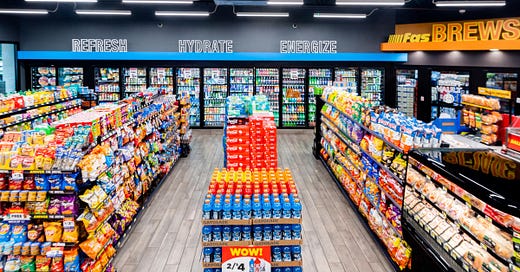Ticker: $ARKO
Price: $4.65
Market Cap: $530M
TTM P/E: 151x (killed by amortization)
2026 P/E (est): 113x (lol but slightly better)
Price/Book: 2x
Insider Ownership: ~30%
Debt: $866M
Notes: Junk-rated, but at least it's honest about it
The Pitch
What if I told you there’s a deeply unloved, semi-janky convenience store roll-up with a junk bond rating, sagging sales, and a CEO who spends more time bragging about how much subsidized fuel they are giving away than the company’s strategy? But it spits off 11% FCF yield to market cap?
You’d probably call it a value trap. Maybe it is. Or maybe it’s just ugly duckling capitalism — a company that was doing dumb stuff, realized it, and is now flipping the script with a dealerization strategy that actually makes sense.
This is $ARKO. It’s not sexy. But it might make you money.
What It Is
ARKO is what happens when you take 25+ crusty regional gas station brands, slap them together under one roof, and try to make them share a toothbrush. It operates 1,300+ convenience stores and distributes fuel to nearly 2,000 others. It owns almost no real estate, leases most of its stores, and used to buy everything in sight like it was playing Monopoly drunk (thanks, private credit).
It went public via SPAC in 2020 (red flag, but we’ll look past it). Stock is down ~50% since then. They’re pivoting now, trying to go asset-light, offload underperforming stores, and actually manage capital like adults. Imagine that.
Why Now?
ARKO’s kitchen-sink phase is over. The management team, which owns ~30% of the company, is finally doing shareholder-y things. Like buying back stock. Like remodeling stores to sell food other than frozen pizza. Like offloading subscale stores to mom-and-pop operators via the so-called "dealerization strategy."
Translation: shift bad stores to suckers, keep the good ones, and keep supplying everyone fuel at a healthy clip. It’s unglamorous, but smart.
FCF Machine (Sorta)
Let’s talk numbers. TTM levered FCF: $138M. Market cap: $530M. That’s a fake-sounding 27% yield. Yes, working capital helped ($80M bump), so the normalized FCF is closer to ~$60M or ~11.3% yield. Still very real. The remaining dealerization creates a short-term FCF bump as inventory is sold and not replenished.
Capex is mostly maintenance, with some money thrown into food service pilots and greenfield locations. So far they’ve remodeled 7 stores and opened 4 new ones. Sounds small, but if they get it right, they can scale up with a big payoff
Segments That Print
Retail (OG c-stores): $276M in operating income. Under pressure, yes, but with upside via foodservice. Almost sold for $2B in September, but the figure probably included the assumption of leases.
Wholesale (Dealer fuel & rent): $80M op income. Quietly solid, rides on the back of GPM.
Fleet Fueling: $50M op income. Unmanned gas for truckers, boring but stable.
GPM (Fuel distribution mothership): $98M op income. Takes 5 cents per gallon like a toll booth.
If the dealer strategy works, wholesale/GPM go up as retail slowly fades (by design).
Dealerization = Hidden Upside
ARKO plans to move a chunk of its lower-return stores to franchisees, collect rent, and supply fuel. That’s it. $20M in incremental op income expected, with less capex required and less operating headache.
It’s a win-win. The franchisees hustle for themselves. ARKO skims the rent and makes a dependable annuity on fuel sales. It’s like McDonald’s if you replace burgers with Marlboros and Monster energy drinks.
What Sucks (Because Something Always Does)
Leverage: $866M in debt + $200M in finance leases. Oof. Bonds due 2029, currently trade with a 16% discount.
EV risk: If the US gets serious about electric cars, gas stations become Blockbusters with Slim Jims. Not a concern of the market. Being in poor areas might actually benefit them here.
Sales trends: Same-store sales for merch were down nearly 7%, worse than peers. Blame inflation, black market vapes, Sleepy Joe, whatever. Still bad optics.
S&P Rating: B (for busted)
But Wait… There’s Alignment
CEO Arie Kotler owns nearly 20% of the company and has been running the show since 2011. Other execs have history. CFO was poached from Giant Eagle. GC’s been there for over a decade. These aren’t hired guns, they’re lifers. Good or bad? You decide.
Board is stacked with old PE guys and a suspicious number of Heyers. Classic SPAC DNA.
Wrap Up
This is a misunderstood little beast that could re-rate if management keeps playing it smart. The FCF yield is real. The buybacks are happening. The junk debt offers an attractive and guaranteed FCF bump if it is repurchased. And best of all, they stopped doing dumb acquisitions.
The stock trades like it’s going to zero. But there’s a real business here, and with a few more quarters of competent execution, you could see meaningful upside.




Hey check out also my report on $KLTO
Mouse study, tons of dilution and some key red flags..
https://substack.com/@redflagresearch/note/c-126439408?r=1unfoz&utm_medium=ios&utm_source=notes-share-action
why dont they cut the dividend first